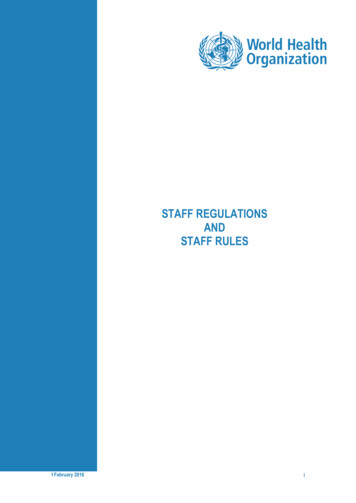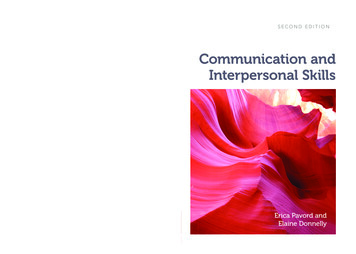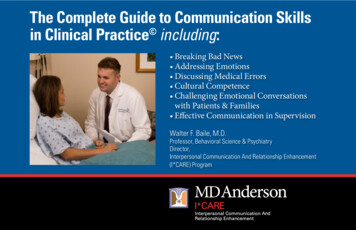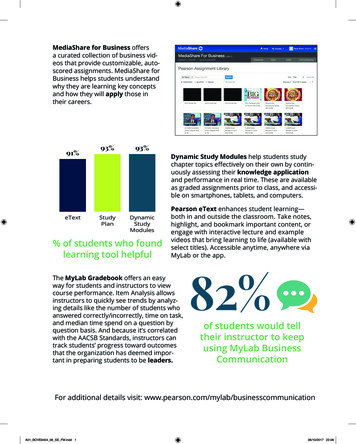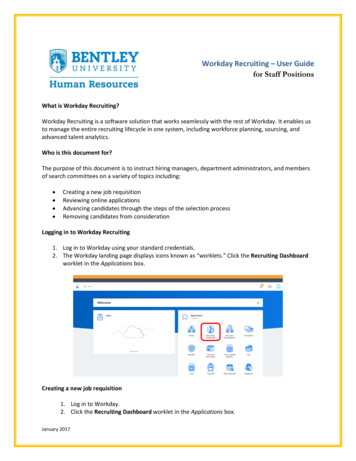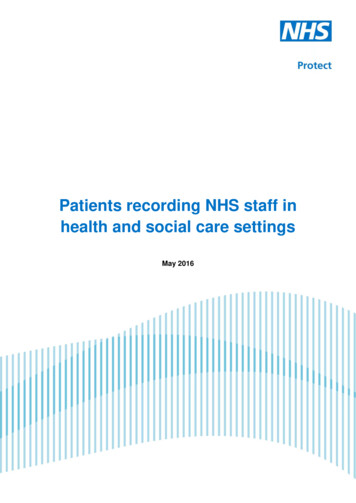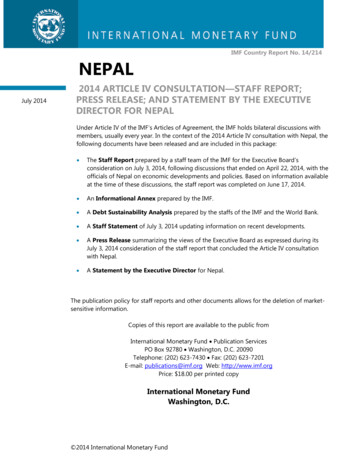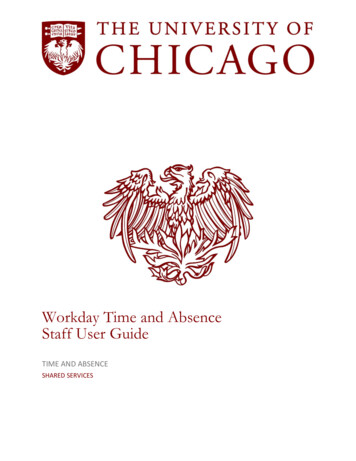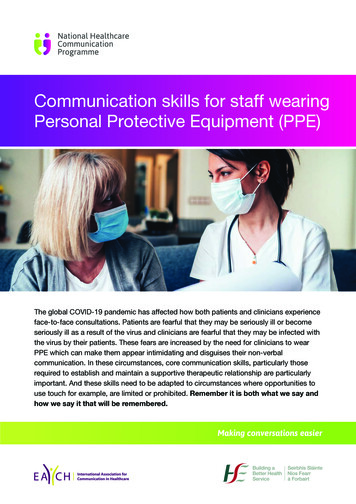
Transcription
Communication skills for staff wearingPersonal Protective Equipment (PPE)The global COVID-19 pandemic has affected how both patients and clinicians experienceface-to-face consultations. Patients are fearful that they may be seriously ill or becomeseriously ill as a result of the virus and clinicians are fearful that they may be infected withthe virus by their patients. These fears are increased by the need for clinicians to wearPPE which can make them appear intimidating and disguises their non-verbalcommunication. In these circumstances, core communication skills, particularly thoserequired to establish and maintain a supportive therapeutic relationship are particularlyimportant. And these skills need to be adapted to circumstances where opportunities touse touch for example, are limited or prohibited. Remember it is both what we say andhow we say it that will be remembered.Making conversations easier
It’s very daunting for patients. All they seefrom when they come through the doors arepeople coming to them wearing PPE. Theyalready feel vulnerable and afraid, and PPEtakes away the humanity.Impact on patientsPPE can heighten patients’ fears of isolation and patients being cared for by healthcare staffin PPE can feel vulnerable and afraid. If you haven’t previously met the patient, PPE can alsopose a significant challenge to building rapport. The quality of patient experience with staffwearing PPE can be affected by: the inability to engage in usual nonverbal social behaviours, such as handshakes/fistbumps, leaning in, and facial cues. the sense of disconnect and distraction created by the PPE and difficulty hearing what thepatient or clinician is saying due to reduced speech clarity. This, combined with the loss oflip reading and visual cues, can make communication between staff and patientsextremely difficult.These barriers compound the existing obstacles to interpersonal interactions,such as cultural and language differences between patients and staff. Despitesome barriers, demonstrating empathy is possible while wearing PPE.Communication skillsCommunication is at the heart of everything we do. It’s central to our relationships, ourwork and our leisure interests. But it’s particularly important in healthcare, where patientscan feel vulnerable, alone and frightened. Research suggests that demonstrating empathyand understanding of a patient’s ideas and concerns enhances the patient experience. Itmay also lead to better clinical outcomes, due to increased patient adherence toproviders’ recommended treatment plans.The protective gear renders communication between staff, and betweenstaff and the patient, more difficult. “It’s really difficult to hear each other”so what can healthcare staff do to address this?www.hse.ie/nhcprogramme@NHCProgramme
Calgary-Cambridge GuideCommunication skillsWe don’t intend to tell you exactly what to say, instead we are highlighting certain skillsand providing a series of useful phrases under the relevant sections of theCalgary-Cambridge Framework.Initiating the sessionGathering information Explore the patient’s problems Understanding the patient’s perspectiveProviding information & planning Provide correct amount and type of information Aid patient recall and understanding Incorporate the patient’s perspective Shared decision making and planningClosing the session Ensuring appropriate point of closure Forward planning Greeting and introductions Non-verbal behaviour Involve the patient and share your thinking Empathy Making organisation overt Attending to flowPhysical examinationBuilding the relationshipProviding structure Preparation Establishing initial rapport Identifying the reasons for the consultationAdapted From: Silverman, J., Kurtz, S., & Draper, J. Skills for Communicatingwith Patients (3rd ed). Oxford: Radcliffe Publishing (2013).www.hse.ie/nhcprogramme@NHCProgramme
Initiating the sessionPreparationPrepare yourselfIt can be hot and uncomfortable to wear full PPE. Be aware of how you are feeling. Takeregular breaks as necessary.Prepare the environmentTry to minimise background noise or move to a quiet area if possible.Building the RelationshipGreeting & Introductions Ensure that your name badge is visible and easy to read. Identification boards can be useful for staff whose face is covered by personalprotective equipment (PPE), for example, photographs of its staff on a board in thewards to help patients identify with the person behind the mask. So, when staffintroduce themselves, they point to the board and say: “This is me, this is who you aretalking to and I’m looking after you today”. Wear a clear photograph of your smiling face.Non-verbal behaviour PPE face masks reduce speech clarity and combined with the loss of lip reading and visual cues make communication between staff and patients more difficult. If it ispossible, use a plastic ‘see-through’ visor. Face the patient and make sure they arelooking at you before communicating.Look directly at the patient and make good eye contact.Lighting on the healthcare workers face is important. Try not to stand with a light orwindow behind you and don’t cover your mouth or face with your hand.Be responsive in the conversation. Support understanding by intentionally usinggestures and body language to communicate information.Even though the patient may not be able to directly see your face and some of yourgestures bear in mind that your non-verbal communication will be transmitted to somedegree and will be picked up by the patient. Also, allow the patient a little more time topick up on your non-verbal communication as it is disguised by the PPE.www.hse.ie/nhcprogramme@NHCProgramme
Touch Where touch is appropriate, it is okay to use this to comfort patients while wearing PPE.Positioning Do not speak to the patient while you are moving about.Involving the patientDevices If the patient uses a hearing aid or listening device ensure that they are available and in use. Acknowledge the impact that PPE/not shaking hands/distance has on thecommunication “Now I know I appear a bit intimidating dressed in all this gear but I doreally want to understand what’s being going on for you and how you feel about it all”.Gathering informationExplore the patient’s problems The most important thing you can do is to listen carefully to questions and concerns. Summarise your understanding of the patient’s problem – this demonstrates you haveunderstood the patient fully, despite the barriers of PPE. Name the emotion and use verbal empathy since it can be difficult to express empathynon-verbally while wearing PPE. Ask clear, open-ended questions to elicit a list of needs up front.Understand the patients perspective Explore ideas, concerns, and expectations from the patient’s perspective.Providing information & planningProvide correct amount and type of information Slow down. Provide information in small chunks – the additional stress of theconsultation means the patient needs more time to process the information you areproviding. We normally learn a lot from patients facial expressions, and if the patient iswearing a mask, it can be difficult to gauge their degree of concern or bafflement whenyou cannot see the bottom half of their face. Encourage questions and keep checking understanding "please stop me if.". Thisallows the patient to let you know if they can't understand what you are saying becauseof the PPE.www.hse.ie/nhcprogramme@NHCProgramme
Aid patient recall and understanding Speak clearly and at a slightly slower pace, but don’t shout or overenunciate mouth movements. Keep your head fairly still.The patient may want to communicate by note-writing, this will take a little longer,please be patient and if necessary, respond by writing.Be prepared to repeat and rephrase information if necessary. Ask questions to checkunderstanding.Invite the patient or colleague to summarise their understanding of the informationand/or plan.You may not have an answer for every question: a lot is still unknown about COVID-19and it is okay to admit that.Visual aids If available, share information pamphlets or hand-outs with your patients. Refer to visual information (drawings, diagrams or photographs) during conversations. Another solution is for staff to use a whiteboard on which to write messages.Closing the sessionEnsuring appropriate point of closure Be sure to finish the consultation with a clear plan of how the patient is going tocontinue to receive on-going support. Check for understanding of the plan and anyagreed next steps.Document reference numberDocument developed byVersion numberDocument approved byApproval dateRevision dateNHCG‐D‐024‐1National HR DirectorateV1.1National Healthcare Communication GroupMay 2020May 2021www.hse.ie/nhcprogramme@NHCProgramme
Adapted From: Silverman, J., Kurtz, S., & Draper, J. Skills for Communicating with Patients (3rd ed). Oxford: Radcliffe Publishing (2013). Building the relationship Greeting and introductions Non-verbal behaviour Involve the patient and share your thinking Empathy Provid
